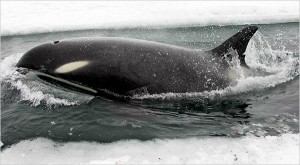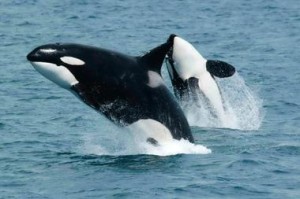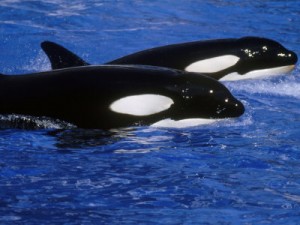
May 3, 2010

Trawler captain Billy Train of Falmouth, Maine, photographed this killer whale while fishing off the coast of Massachusetts. Although such sightings are rare, it was the second time for Train, who said he saw two orcas while fishing in 2005. Photo: Billy Train.
Yes, there is photographic proof that a killer whale, in an unusual appearance late in April 2010, was seen on Georges Bank, a famed fishing ground 100 miles east of Boston. But one might wonder, what species of killer whale or orca was it?

An Antarctic ecotype of orca, or killer whale, that preys on fish. Photo credit: Robert L. Pitman/NOAA Southwest Fisheries Science Center
All orcas are currently classified and included in a single species, Orcinus orca. But that appears to be on the verge of changing. New findings note there may be at least three species of orca.
Molecular biologist Phillip A. Morin of the National Oceanic and Atmospheric Administration’s Southwest Fisheries Science Center in La Jolla, California, studied all the DNA in the mitochondria of tissue samples from 139 orcas. The team’s results, he said, “clearly show that these different groups are genetically distinct.”

The killer whales that eat seals exclusively are one such distinct species, as are those that eat only fish. A group of “mammal-eating transient killer whales” in the North Pacific are a third species. At least two other groups may also be separate species, but further studies of nuclear DNA will be required to prove it, Morin said.

There is no recognized international group responsible for naming such new species, Morin said. Some investigator will probably compile all the information about each distinct species and then a name will be proposed. “That is a field of its own,” he said.
The new study of the orca genetic evidence was published in the April 22, 2010 issue of the journal Genome Research.
Sources: 1, 2, 3, and 4. The abstract of the paper is here.
About Loren Coleman
Loren Coleman is one of the world’s leading cryptozoologists, some say “the” leading living cryptozoologist. Certainly, he is acknowledged as the current living American researcher and writer who has most popularized cryptozoology in the late 20th and early 21st centuries.
Starting his fieldwork and investigations in 1960, after traveling and trekking extensively in pursuit of cryptozoological mysteries, Coleman began writing to share his experiences in 1969. An honorary member of Ivan T. Sanderson’s Society for the Investigation of the Unexplained in the 1970s, Coleman has been bestowed with similar honorary memberships of the North Idaho College Cryptozoology Club in 1983, and in subsequent years, that of the British Columbia Scientific Cryptozoology Club, CryptoSafari International, and other international organizations. He was also a Life Member and Benefactor of the International Society of Cryptozoology (now-defunct).
Loren Coleman’s daily blog, as a member of the Cryptomundo Team, served as an ongoing avenue of communication for the ever-growing body of cryptozoo news from 2005 through 2013. He returned as an infrequent contributor beginning Halloween week of 2015.
Coleman is the founder in 2003, and current director of the International Cryptozoology Museum in Portland, Maine.
Filed under Breaking News, CryptoZoo News, Cryptozoologists, Cryptozoology, Evidence, Eyewitness Accounts, Forensic Science, Megafauna, New Species, Photos, Weird Animal News